Dainty Suggestions in Bridal Lingerie – April 1914
By Helen Peabody
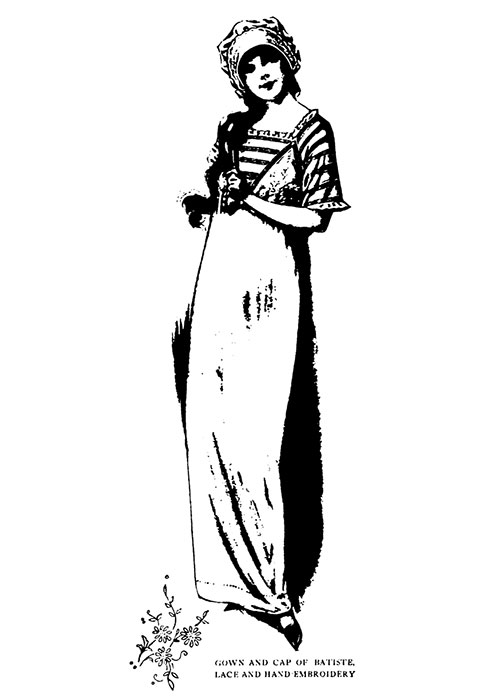
Gown and Cap of Batiste, Lace, and Hand-Embroidery
On our opening page of fashions this month you will find that all-important garment — the wedding gown —presented in all its incredible white beauty and graceful lines.
As this issue of our magazine is primarily intended for the bride-to-be and her needs—elaborate or simple, whichever they may be—it seems most appropriate for me to offer on these pages suggestions for lingerie.
New and excellent designs for garments shown will prove most acceptable additions to trousseau or to replenish any supply of lingerie.
Her financial resources must always govern a bride's needs, and even though it is found unnecessary to count the cost.
It is better to have a small assortment of well-chosen underwear of suitable material, well made and trimmed with good lace, embroidery, or here and there a touch of one's own dainty hand-embroidery, than to have no end of useless, fussy things which in themselves are not pleasing and require much labor in laundering.
One of the great faults to be found in ready-made underwear is the over-abundance of cheap lace which might well be replaced by better quality in the material of the garments.
At present, undergarments need but a minimal quantity of material: in fact, one can make almost two garments out of the amount necessary for one as made a few years ago.
The majority if of materials used are soft and light in weight, for there is no room for bulky underwear under skirts and dresses of present-day style.
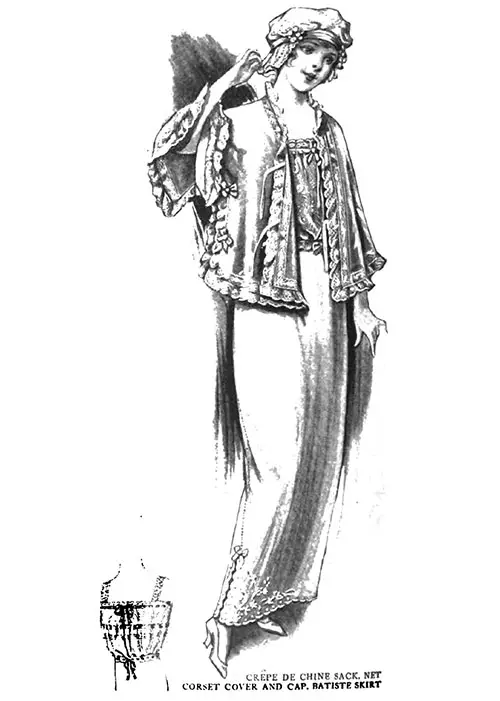
Crepe de Chine Sack, Net Corset Cover, and Cap, Batiste Skirt
For nightgowns, one may use batiste—which is the prettiest material for beautiful nightgowns—long-cloth, cambric, and nainsook, the last three fabrics are more durable. Cotton Crepe, much used in its various degrees of fineness, gives ample satisfaction because it is nice to wear and easily laundered.
When warmth is needed—for we all do not live in tropical or temperate climate—Canton flannel, flannelette, Scotch flannel and fine muslin serve this purpose well.
When one does not wish to be particularly practical, crepe de Chine—which washes well if squeezed through a suds of slightly warm water and pure white soap—or wash silk may be used for more elaborate gowns, but as such materials do not take kindly to the boiling process, many of us will prefer using the more hygienic cotton fabrics for all underwear.
The gown shown on the first figure will make a pleasing addition to any wardrobe, made of batiste, with rows of dainty lace and hand-embroidery for decoration, and you will find it very easy to make.
The becoming little cap that so reminds one of Priscilla pictures is of batiste, hand-embroidered to match the gown.
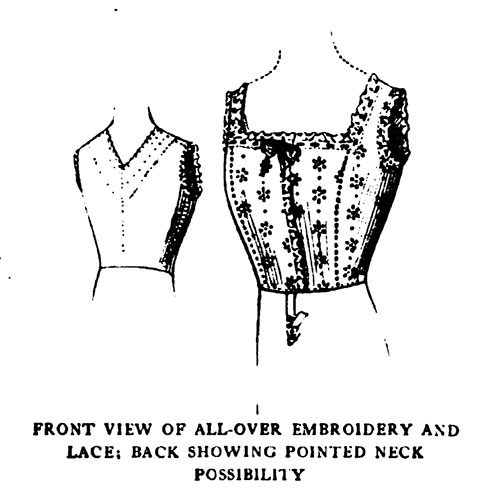
Front View of All-Over Embroidery and Lace; Back Showing Pointed Neck Possibility
For wear under beautiful lingerie dresses or evening gowns, slips of sheer lawn, batiste, crepe de Chine, China, and mescaline silk, in white and delicate colors, are used; while for general use, those of long-cloth, cambric or nainsook give greater satisfaction.
The slip of our illustration is a perfect style for evening and formal wear, and the model provides for a higher neck in round outline, for a front or back closing, and narrow gathered flounce.
All materials suitable for slips are adaptable for petticoats, and no more straightforward, better design could be selected for the latter garments than the model shown with the dressing-sack on the second figure.
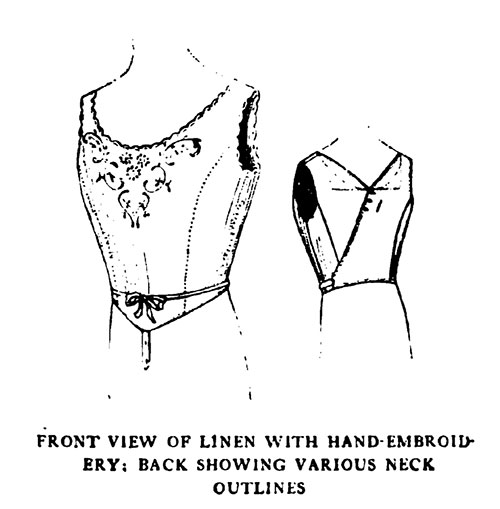
Front View of Linen with Hand Embroidery; Back Showing Various Neck Outlines
It is illustrated here in fine batiste, with hand embroidered design and scalloped edges, and the seam at each side joined with French seam-veining.
Such a skirt is wonderfully easy to make; the model supports a plaited flounce, and the seams may be entirely closed if preferred. When the frill is used, the upper part of the petticoat will be helpful if made of silk jersey-cloth and the flounce of mescaline or taffeta.
Moreover, you will agree with me that a petticoat of percaline, sateen or gingham is never found wanting in usefulness. Batiste, nainsook, cambric, and long-cloth are most beautiful for combinations, corset covers, and drawers.
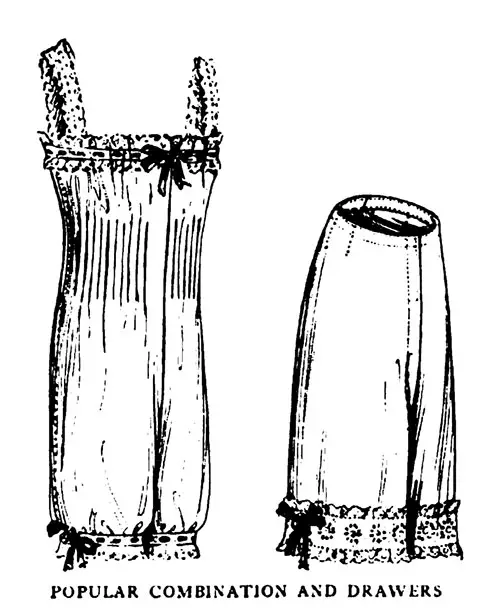
Popular Combination and Drawers
All these materials, as well as linen, all-over embroidery, sturdy lace, and net, will make attractive brassieres. Both front and back closing ones are favored, two great types being illustrated.
Many women prefer them in place of corset covers, not always as bust confiners, but because they give to the figure desirable trim lines.
The little corset cover shown under the sack is of the all-over figured net. This sort of garment is well liked for wear under transparent shirtwaists, adding to their daintiness, and is often made of rows of inserting alone or alternating with rows of ribbon.

Suggestions for Garters and Sachets
The sack is delightfully becoming in pale pink crepe de Chine, with its trimming of shadow lace inserting and the softly frilled lace finishing all edges. Pink ribbon bows hold the underarm edges together, in place of the regulation seams, while ties of the same ribbon are used for the fastening.
The boudoir or breakfast cap is in dotted Brussels net, lined with the pink crepe de Chine and with lace frill, pink ribbon band, and rosebuds.
The hearts of these tiny buds are filled with sweet sachet powder in the wearer's favorite perfume. This idea is repeated wherever the rosebuds are used for decorating other garments such as the garters, three-cornered and rose-cluster sachets.
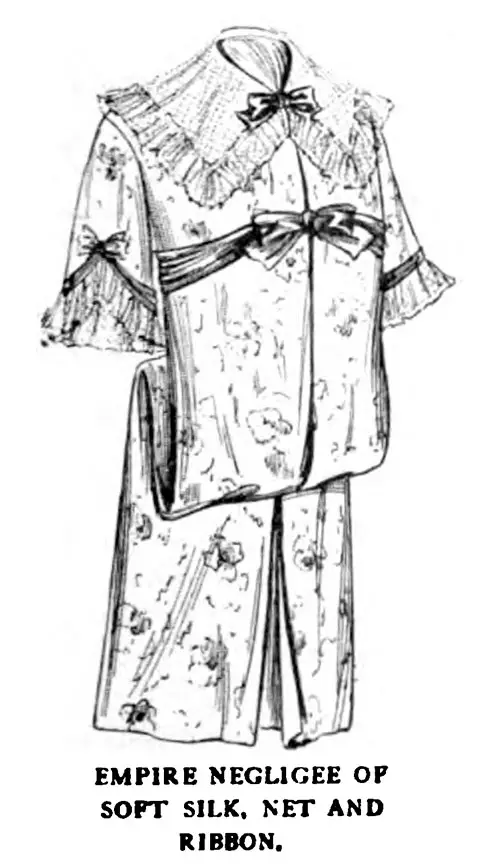
Empire Negligee of Soft Silk, Net, And Ribbon
Also, all these little dispensers of fragrance, together with ribbons, are to be removed before the garments are laundered.
For combinations, the everyday materials suggested for drawers and corset covers are best. The model given the former once tried will always be used, with small buttons and buttonholes for the fastening, and is decidedly satisfactory.
The method of trimming shown, just a fiat band of lace inserting, with narrow lace frill at both edges, is most fashionable.
The seams of the best underwear are usually French-seamed with French seam-veining, and in our February lesson, this was described and illustrated. Seams of undergarments for general wear are made with plain French seams.
On fine underwear one may use crocheted buttons; lace and hand-embroidery combined, or lace alone, and the best laces to use are French or German Valenciennes and fine Cluny.
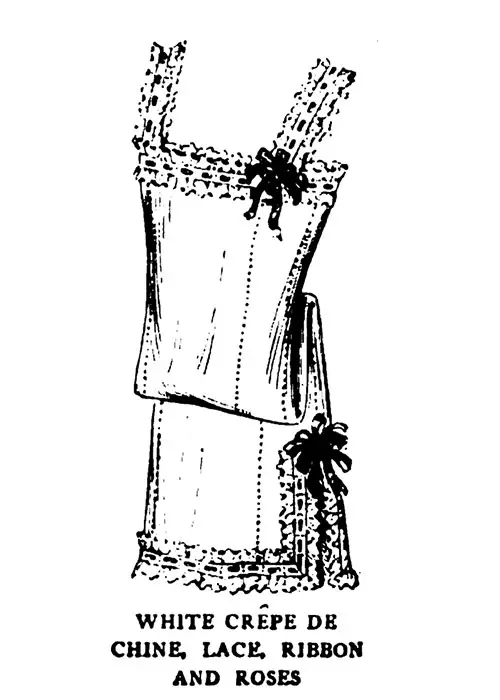
White Crêpe De Chine, Lace. Ribbon, And Roses
The two latter laces wear better than the former. Excellent imitations can be had in all these laces, and in making a choice, you can just as well choose good designs as ordinary ones.
Machine-embroidered inserting and edging make great underwear trimming and are very pretty in simple and not heavy designs. For underwear that will see hard usage, you will find linen torchon lace a serviceable trimming.
No wardrobe, either bridal or otherwise, is complete without its negligee, and Empire styles are much favored.
Here, one is shown in soft Japanese silk, with net collar and lace frills, and the Empire waist effectively outlined with soft ribbon and bow. Cotton crepes, voile, lawn, swiss, China silk, albatross, flannel, and challis are all acceptable fabrics for kimonos and dressing sacks, according to climate and one's means.
Miss Peabody is pleased to reply by letter to inquiries on dressmaking topics. A stamped, self-addressed envelope must be enclosed. Address any difficulties or questions you may have to Miss Helen Peabody. The Woman's Magazine
. —The Editor.
Peabody, Helen, “Dainty Suggestions in Lingerie: For Bridal Trousseau or Simpler Wardrobe” in The Woman's Magazine, New York: The New Idea Publishing Company, Vol. 29, No. 4, April 1914, p. 32-33.
Editor's Note: Some terminology used in the description of women's clothing during the 1800s and early 1900s has been changed to reflect more modern terms. For example, a women's "Toilette" -- a form of costume or outfit has an entirely different common meaning in the 21st century. Typical terms applied to "toilette" include outfit, ensemble, or costume, depending on context.
Note: We have edited this text to correct grammatical errors and improve word choice to clarify the article for today’s readers. Changes made are typically minor, and we often left passive text “as is.” Those who need to quote the article directly should verify any changes by reviewing the original material.

